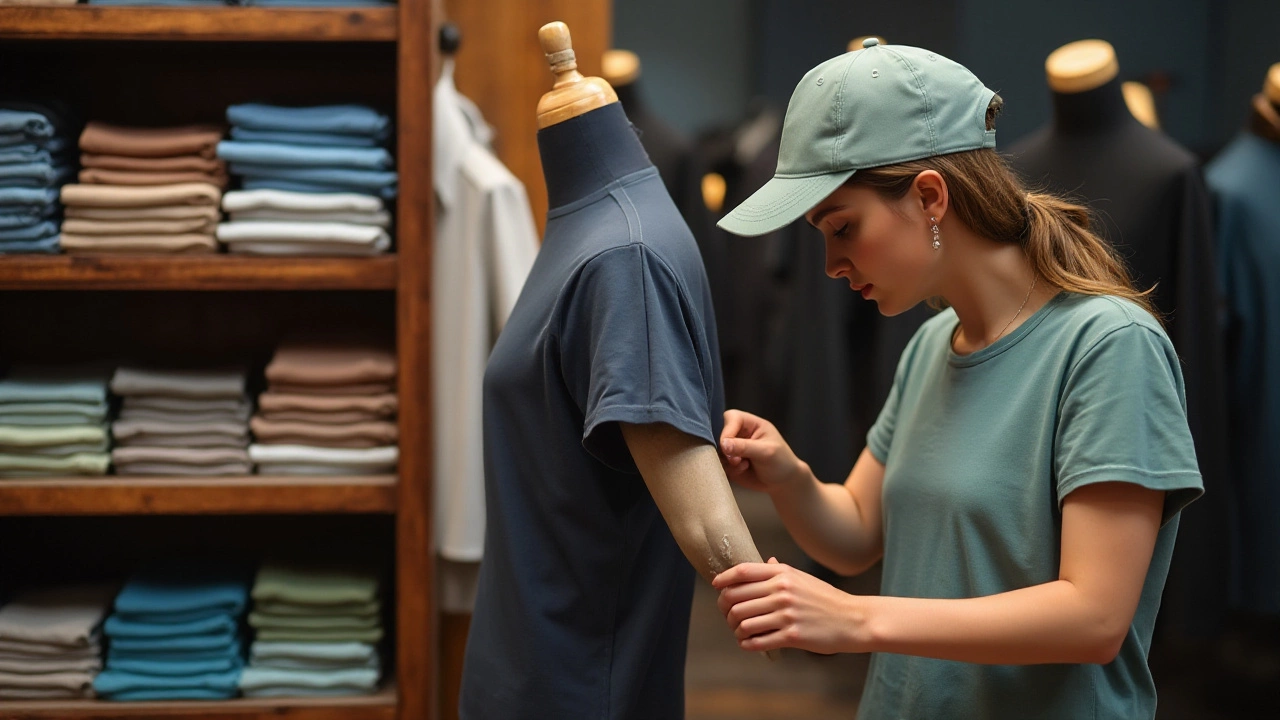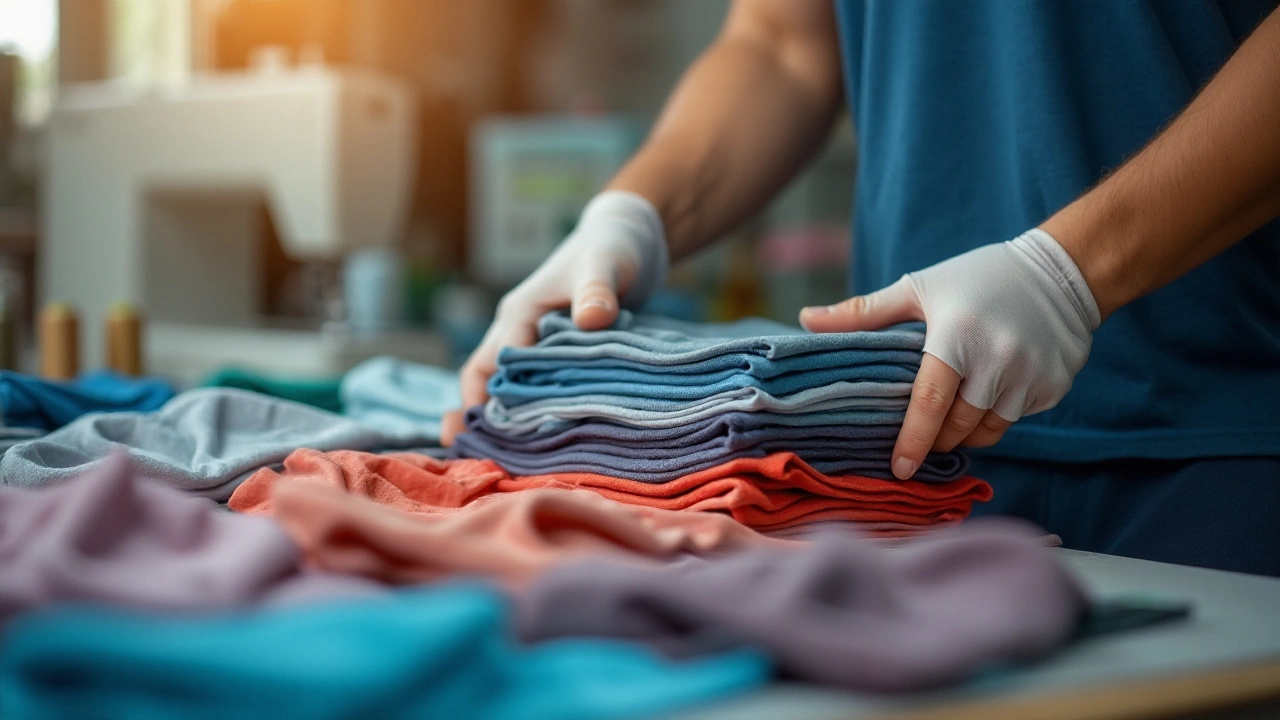When it comes to choosing a t-shirt that stands the test of time, knowing what's behind its quality can make all the difference. Often, people overlook the subtleties that define a high-quality piece of clothing, opting instead for enticing designs or catchy slogans. But quality isn't just about what's printed on the surface; it's about the fabric, the workmanship, and the overall build of the garment.
Whether you're seeking comfort for everyday wear or a reliable base layer, delving into the nuances of fabric, stitching, and even color retention will pay off in the long run. Let's explore these aspects one by one, providing insights to help you become adept at distinguishing extraordinary t-shirts from the ordinary ones.
- Fabric Matters
- Stitching and Seams
- The Importance of Fit
- Longevity of Color
- Brand Reputation
- Tactile Feedback
Fabric Matters
When discussing the quality of a t-shirt, the fabric is often the first feature that demands our attention. A fabric not only impacts how a garment feels against your skin but also plays a significant role in its durability and elasticity. The most common material for t-shirt quality assessment is cotton. But not all cotton is created equal. There are several varieties like Pima, Supima, and Egyptian cotton, each offering different levels of softness, strength, and lasting power. For instance, Pima cotton is renowned for its silk-like softness and less pilling, making it an ideal choice for enhancing comfort and durability.
Another important factor to consider is the fabric weight, expressed in grams per square meter (gsm). Lighter fabrics, around 140 gsm, are breathable yet might not provide the same durability as heavier fabrics, which might be around 180 gsm or more. Heavier materials are usually more robust, lending more structure and warmth, which is suitable for cooler climates. Various fabric blends add versatility, allowing for combinations like cotton-polyester, where the blend offers stretch and crease resistance, proving itself to be less prone to shrinking.
One of the most critical but often underrated aspects is the weave of the fabric. A well-made weave will give the shirt its resilience and strength. Tight weaves, like those used in jersey or interlock fabrics, enhance longevity and maintain form through numerous wearings and washings. According to a quote from fashion expert James Laul, "The weave dictates not only the hand-feel but the long-term performance of a garment."
It is also worthwhile considering the environmental impact of the material. Organic cotton t-shirts support sustainable farming practices, which avoid harmful chemicals and pesticides, making them an eco-friendly choice. Choosing a high-quality, sustainable fabric is not only beneficial for the environment but also rewards you with a longer-lasting garment. When evaluating fabric durability, take time to feel the fabric and even perform a quick check by stretching it. Does it return to its original shape? This elasticity is a good indicator of how well the garment will fare over time.
A visually appealing aspect like color retention is often overlooked but it's closely tied to the quality of the dye and fabric. Ensuring the t-shirt will maintain its vibrant hue over multiple washes improves the garment's lifespan and aesthetic appeal. Label information and care instructions can offer invaluable insight into both quality and maintenance practices. For instance, garments that recommend machine or cold washing denote dyes and fibers that might be less prone to rapid fading or shrinking.
In today’s fashion-cautious age, understanding the role fabric plays in a t-shirt's quality helps in making informed purchase decisions. So next time you're on the lookout for that perfect addition to your wardrobe, give more than a glance to the tag. Your knowledge of fabrics could save you from dissatisfaction in the long run, and perhaps highlight a shirt that will become a cherished and enduring part of your clothing repertoire.
Stitching and Seams
Examining the stitching and seams of a t-shirt can reveal much about its quality and durability. These are the hidden lines that hold the garment together, but they are often an overlooked aspect when people evaluate clothing. Pay close attention to the stitches themselves; they should be even and tight, indicating that a capable sewing machine and a skilled workforce were involved in the making of the shirt. High-quality shirts tend to use a smaller, tighter stitch count which ensures a more secure construction that won't fray over time. Seam types also come into play here, with choices like French or flat-felled seams offering added durability and a smoother finish.
While inspecting a t-shirt in the store or when you first receive it, gently tug on areas near the seams to test their resilience. A high-quality t-shirt should maintain its structural integrity without threads pulling apart or distorting the fabric. Often, these details are not visible from a distance but become apparent upon closer inspection. Brands known for quality will care as much about the inside of the garment as they do about the outside, sometimes incorporating double-stitched or even reinforced seams for extra durability, especially in areas under stress like the shoulders and armholes.
Interestingly, some premium brands might use a particular thread type that complements the fabric's qualities, such as polyester threads for cotton fabrics owing to their strength and resistance to shrinking and mold. Cared-for construction points to a garment that won’t just look good initially but will remain in your wardrobe for years. According to Robert Voss, a respected textile expert, "The integrity of a garment lies in its finishing touches. Seams and stitches are to clothes what foundations are to buildings." Not all quality can be seen directly, understanding these subtle details ensures informed decisions.
Let's not forget about the finishing of the hems and edges. The neatness of hems and their alignment with the rest of the shirt might seem a minor element, but it's an indicator of careful, high-quality construction. Ideally, the edges should lay flat and not bunch up, maintaining the shirt's shape. Certain techniques like overlocking are used in quality garments to prevent edges from fraying and to provide a clean finish.
A great practice is to flip the shirt inside-out when examining in a store. The inside should be as neat as the outside. Uneven stitching or excessive loose threads can often be a red flag for eventual unraveling. With time and some practice, distinguishing between a slapdash stitch job and a robust construction becomes an easy task. These carefully executed details make for the backbone of what high-quality clothing should be.

The Importance of Fit
Fit is a critical factor when choosing a high-quality t-shirt that many people often overlook. While it might seem like a straightforward choice between the simple labels of 'Small,' 'Medium,' or 'Large,' the reality is more nuanced. A well-fitted t-shirt can greatly enhance your overall appearance and boost comfort levels, making it feel almost like a second skin. It’s amazing how a simple adjustment in how a shirt fits can change not only how you look but how you feel.
When trying on a t-shirt, pay close attention to how it sits on your shoulders. The seam should ideally sit right at the edge of your shoulder, not too far down your upper arm, and definitely not pulling up on your neck. This alignment is the foundation of fit, affecting both the silhouette and the durability of the garment. Ill-fitting seams can stress fabric, leading to misshapen drapes or tears over time. You wouldn't believe the difference this simple observation can make!
Another fitting detail is the shirt’s length. The ideal length varies depending on personal preference and body type, but generally, the hem should hit around the middle of your trouser's zipper. Too short, and you risk unintended exposure; too long, and you might look like you're wearing a nightgown. Fit can impact the t-shirt's construction as repeated tucking and un-tucking can weaken the fabric's resilience.
As renowned fashion expert Tim Gunn once said, "The fit is everything. You have to enjoy wearing the item that makes you feel amazing."
Pay attention to the arms as well. The sleeves shouldn't be excessively tight or loose. A snug fit around the upper arm that allows some movement is generally preferred. This balance ensures comfort without looking sloppy and complements the t-shirt’s design, reinforcing that its quality isn't just about the material but how it works with your body. Fit is not just about current fashion trends; it’s about finding what suits you best. This journey might sound tedious, but trust me, when you find that perfect fit, there's no going back.
Finally, consider how the shirt's width feels around your torso. A standout feature of high-quality clothing is the balance between a fit that's close but not constricting. The material should gently follow the natural lines of your body without appearing taut or excessively bunched. Understanding fit is an essential skill that elevates your ability to choose and maintain a versatile wardrobe. Comprehending these fit basics ensures you not only select pieces that last longer but also ones you'll reach for time and again.
Longevity of Color
A high-quality t-shirt is not just about how it feels or fits, but also how well it can maintain its vibrant color after multiple washes. Color longevity is crucial because it determines the lifespan of the clothing's aesthetic appeal. Fabrics that fade quickly can make even the most expensive t-shirts look worn out and shabby. Most high-end t-shirts go through a thorough dyeing process where the colors are locked into the fabric's fibers. This technique ensures the t-shirt continues to look new for a longer period. Many brands use reactive dyes, known for creating strong bonds with fibers, resulting in long-lasting colors.
One compelling aspect of t-shirt color retention is the influence of fabric type. Natural fibers like cotton tend to hold dye better compared to synthetic fabrics like polyester. This is because natural fibers have more porous structures, allowing dyes to penetrate deeper into the fabric. In contrast, synthetic fibers often require additional treatments to absorb dyes properly. When shopping for a t-shirt, it’s a good idea to give preference to those made with combed or ring-spun cotton, as they typically absorb dye more evenly. Many experts in the fashion industry suggest that when purchasing, it's smart to conduct a simple colorfastness test. This involves gently rubbing the fabric with a damp white cloth to see if any color transfers. If it does, that might be a warning sign of subpar dyeing methods.
Seasoned professionals in the textile industry often highlight the impacts of washing techniques on color retention. Harsh detergents and high-temperature washes can leach colors from a t-shirt, reducing its vibrancy. It's advisable to wash colored t-shirts inside-out in cold water with a gentle detergent. Also, air drying is preferable over machine drying to prevent heat damage. Emma Featherstone, a renowned fabric engineer, once said,
“Textiles are like stories; you have to care for them to ensure they last,” adding that mindful laundry practices play a huge role in color sustainability.In households, following these simple yet effective laundry tips can greatly enhance the lifespan of your vibrant tees, ensuring you get the most out of your purchase.
Considering the climate in Melbourne, where high UV exposure can also lead to color fading, it's beneficial to store t-shirts away from direct sunlight. UV rays can be quite damaging to colored fabrics, causing them to fade faster than usual. The risk is especially higher in countries with high levels of sunshine. Therefore, arranging your wardrobe to shield t-shirts from exposure is a key preventive measure. Some t-shirt brands have begun incorporating UV protection into their fabrics, giving an extra layer of defense against the harsh sun. These innovations are reflecting a growing awareness about the need for quality in every element of garment production. By paying attention to these details, you ensure you’re investing in t-shirts that promise durability and enduring color, marrying style with sustainability.

Brand Reputation
In the quest for a high-quality t-shirt, the reputation of a brand can serve as a trusted beacon guiding your choice. Not all brands are created equal, and some have cultivated a strong reputation for consistently delivering high-quality clothing. Such brands often uphold rigorous standards in terms of fabric procurement, manufacturing processes, and ethical practices, all of which contribute to the lasting value of their products. A well-regarded brand often guarantees that you're getting the quality you pay for, which means that a little research into brand reputation can save you from disappointments down the line.
T-shirts made by renowned brands typically undergo meticulous quality checks that cover everything from the fabric to the stitching details. Brands like Patagonia or Everlane, for instance, are known for their commitment to sustainability and quality. They ensure that the cotton used is not only soft and durable but also responsibly sourced. Brands with solid reputations don't shy away from admitting mistakes when they occur, often going above and beyond to rectify them and maintain consumer trust.
According to a report in Vogue, "Trust in a brand is often built on transparency and consistent quality over time. Consumers today value these traits more than ever."
A brand's visibility in the market, investment in community engagement, and the feedback of long-term customers all reflect upon its values and product reliability. High repeat purchase rates and positive word-of-mouth often mark brands that have managed to secure a loyal customer base. Paying attention to what loyal customers have to say can provide a clearer picture of the brand's strengths and potential weaknesses.
Moreover, brands with a reputation for innovation aren't just resting on their laurels, making use of advanced technology to enhance fabric durability or color retention in their t-shirt lines. They're continuously experimenting with new materials that might offer better comfort or are more environmentally friendly, ensuring they adapt to the growing demands for sustainable fashion. All these factors amalgamate into what builds an unshakeable brand reputation. Don't underestimate the power of a good brand — it could very well be your ticket to finding a t-shirt that won't let you down.
Tactile Feedback
When you're standing in front of a rack of t-shirts, or browsing online, the touch and feel provide clues about the garment's quality that are essential yet often overlooked. The tactile response your fingers receive as you touch the fabric can reveal a lot about t-shirt quality. Imagine gently running your hand over different cotton t-shirts; the differences are palpable even when writing cannot do them justice. High-quality t-shirts often possess a softness that invites you to keep feeling the fabric, thanks to longer cotton fibres that contribute to smoother textures. On the contrary, t-shirts that feel rough or scratchy might be made from lower-quality materials that may not withstand the test of time or wear well over multiple washes.
Fabric weight plays a significant role in tactile feedback as well. Lightweight fabrics might feel sheer and airy, ideal for layering, while heavyweight options provide a sense of durability and warmth. This variety, however, should not be misinterpreted as a sign of inferiority or superiority. It's about preference and purpose. For instance, a classic heavyweight t-shirt might serve as an enduring wardrobe staple due to its rugged construction, while a lighter tee would offer versatility during hotter months.
The knit type is also a crucial element. Combed cotton, which is more refined and soft due to its special treatment, often offers a higher quality experience compared to regular cotton. The smoothness and evenness of the weave make it a pleasant experience, especially when worn for prolonged periods. With better quality knit or fibre comes better tactile feedback, translating into a better-wearing experience.
Some experts argue that a t-shirt's texture can influence its visual appeal as well. A smooth, even surface will reflect colors more vibrantly, while a rougher surface might absorb light, making the colors appear duller. Rodney Stevens, a well-regarded textile designer, once said,
"The feel of a garment is the most honest reflection of its quality. What you can see, you can doubt; what you can feel, that's where the truth lies."A simple test such as scrunching the fabric lightly in your hand and observing how it rebounds can give you a hint about its resilience and quality.
Finally, let's not overlook the hand-feel test. When at a store, try to imagine how different fabrics like polyester blend, cotton, or linen feel to the touch. Each material has its own properties: while cotton is breathable and soft, polyester might feel slicker and synthetic. While a blend can offer the best of two worlds, each variant must be tested for personal preference. Engaging your sense of touch not only helps you gauge t-shirt construction but also educates your instincts for future purchases. The more familiar you become with different fabric textures, the better your purchasing decisions will be, honing a valuable skill in a world full of disposable fashion.
